Joro Spider
Trichonephila clavata
Shares its name with a Japanese "spider demon"!
Advertisement
Joro Spider Scientific Classification
- Kingdom
- Animalia
- Phylum
- Arthropoda
- Class
- Arachnida
- Order
- Araneae
- Family
- Araneidae
- Genus
- Trichonephila
- Scientific Name
- Trichonephila clavata
Read our Complete Guide to Classification of Animals.
Joro Spider Conservation Status
Joro Spider Facts
- Prey
- Insects such as mosquitos, yellow jackets, and stink bugs
- Name Of Young
- Baby or spiderling
- Group Behavior
- Group
- Fun Fact
- Shares its name with a Japanese "spider demon"!
- Biggest Threat
- Humans
- Most Distinctive Feature
- Extremely long legs with large abdomen
- Gestation Period
- 2-4 months
- Litter Size
- 400-500
- Habitat
- Anywhere warm and humid
- Predators
- Any mammals that eat spiders and other insects
- Diet
- Carnivore
- Type
- Arachnid
- Common Name
- Joro spider
- Number Of Species
- 1
- Location
- Southeast Asia, though it is an invasive species in some parts of the United States
Joro Spider Physical Characteristics
- Color
- Brown
- Yellow
- Red
- Blue
- Black
- Skin Type
- Exoskeleton
- Lifespan
- 1 year
- Length
- 0.7-2.5 cm (0.28-1 in)
- Age of Sexual Maturity
- 2-3 months
- Age of Weaning
- Birth
View all of the Joro Spider images!
Joro spiders use the wind current to “balloon” on, trailing their silk threads from their body to catch themselves in the air.
The Joro spider shares its name with a folkloric “spider demon” in Japanese culture. Though it was once exclusive to regions like Japan and Korea, it was likely brought to the United States via shipping containers in 2013 and has become an invasive species with thriving populations in some states. When this spider is not building webs, it can travel on wind currents on a string of its own silk.
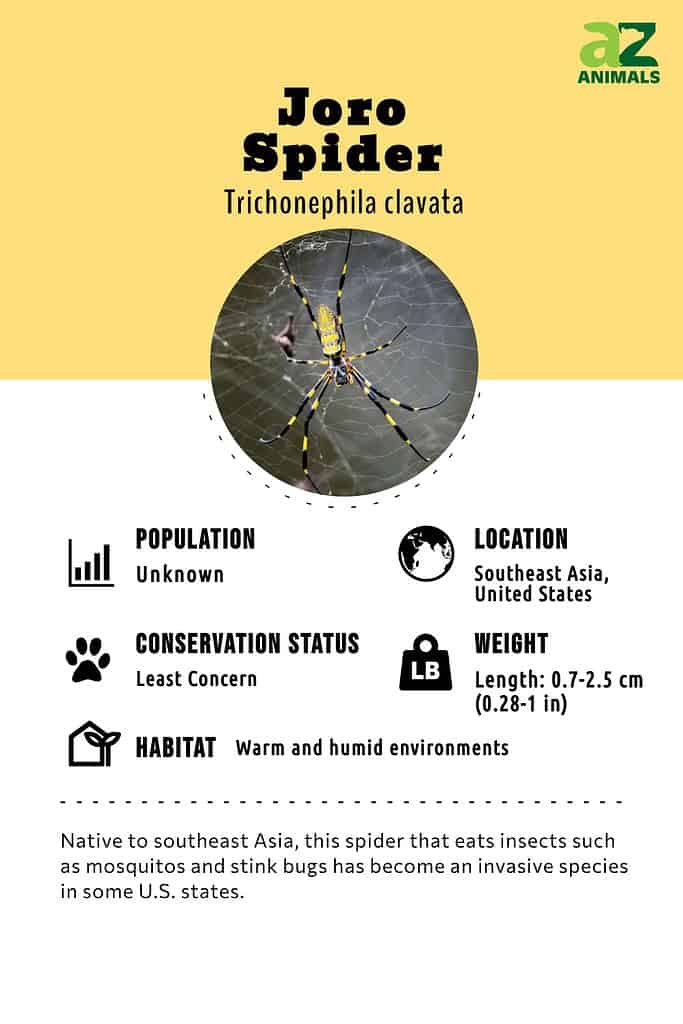
4 Incredible Joro Spider Facts!
Here are a few facts about the Joro spider:
- Despite being venomous, this spider only poses a threat to humans who are allergic to them. Their bite is relatively harmless.
- It is an invasive species, meaning that it is not a native animal to the places where it lives. Experts believe that they traveled on cargo ships, growing in mass numbers in Georgia and other areas.
- While these spiders can look intimidating, they only eat insects such as mosquitos and stink bugs.
- The largest variations of this species can grow to be up to four inches wide.
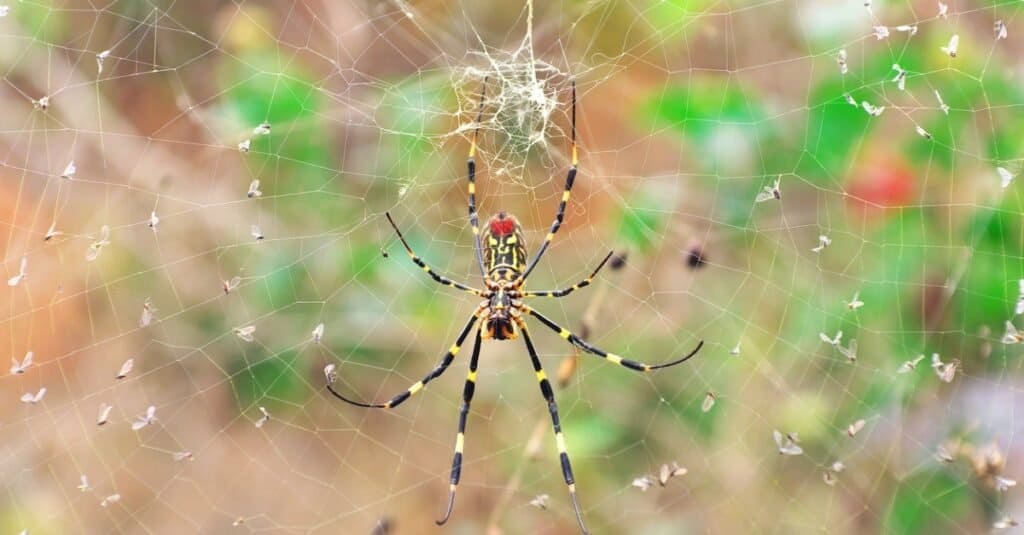
Joro spiders don’t pose a threat to people and only eat insects.
©bozmp/Shutterstock.com
Scientific Name
The Joro spider’s scientific name is Trichonephila clavate. The word Trichonephila was first assigned to the arachnid by Friedrich Dahl in the early 20th century, describing spiders that create woven orbs for their webs. Clavata comes from the modern Latin word clavatus, which means “club.”
It is from the Araneidae family of the Arachnida class. At this time, they have no subspecies.
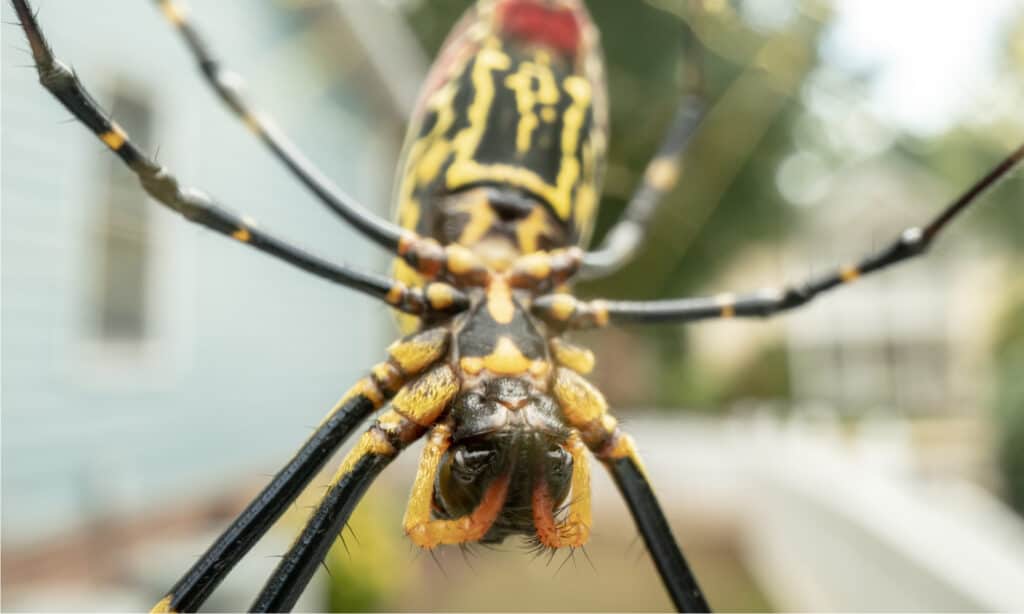
The Joro spider’s scientific name is
Trichonephila clavate.
©Kelly vanDellen/Shutterstock.com
Evolution and History
In Japan, the Joro spider is called “jorōgumo,” which is also the name of a mythical creature in Japanese folklore from the Edo period. The Jorōgumo (the modern translation is “entangling bride”) is a spider who upon reaching 400 years old is able to become a beautiful woman. She then captures men with her web then eats them — which reflects what some female Joro spiders do to males after mating.
Before the Joro spider was introduced to the U.S., the only other known Trichonephila species in the New World was the golden orb weaver (Trichonephila clavipes), also known as the golden silk orb-weaver. The Joro spider and the golden orb weaver spin the same type of orb-shaped web, and the silk they both produce is gold. However, the main difference between these spiders is their physical appearance. While the Joro spider is decorated in gray and dark blue stripes with a red belly, the golden orb weaver is usually brown or black with a silvery or plum-colored abdomen. Both species prefer warm environments, however the Joro spider is native to southeast Asia, and the golden orb weaver is much more widespread and found in Australia, Asia, Africa, North America, and South America.
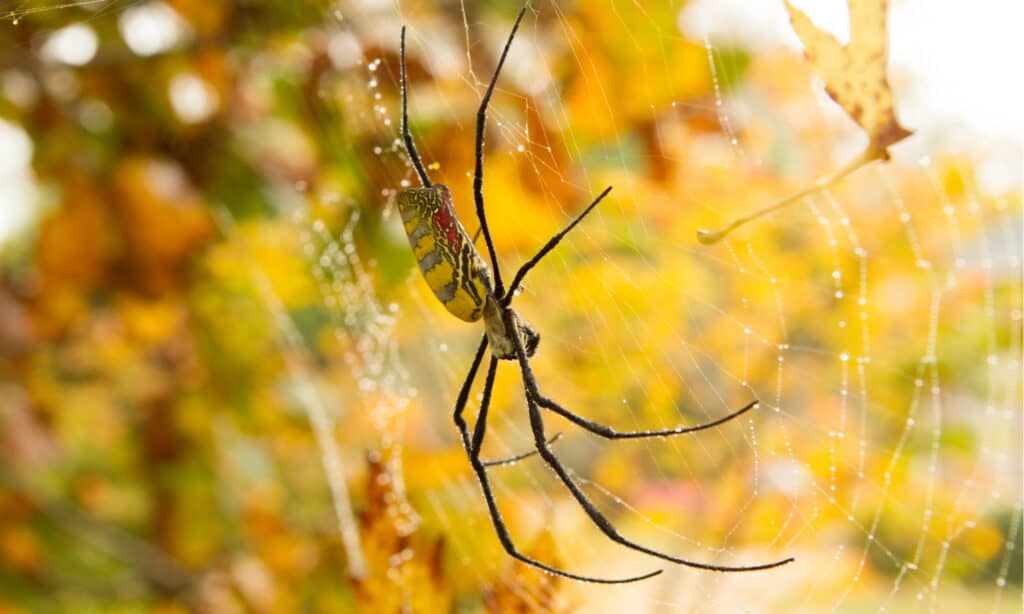
The Joro spider is closely related to the golden orb weaver.
©Richard Sailors/Shutterstock.com
Appearance
The Joro spider is a quite colorful species. Even though males are often the colorful ones in the animal kingdom, the same is not true of this spider. Males tend to have brown and plain bodies. Females, on the other hand, have asymmetrical patterns along their abdomens in black, red, and yellow, complemented by bands of blue and yellow along the legs.
The males and females are relatively close in size as well, though the females are the larger ones. While males range from 0.7 to 1 cm (0.27-0.39 in), the females typically are more than twice this size at 1.7 to 2.5 cm (0.67-1 in) instead. The largest Joro spiders can get even bigger, measuring 7.6-10.16 cm (three to four inches) in diameter in Georgia. However, its only defense is its ability to bite, which is not life-threatening.
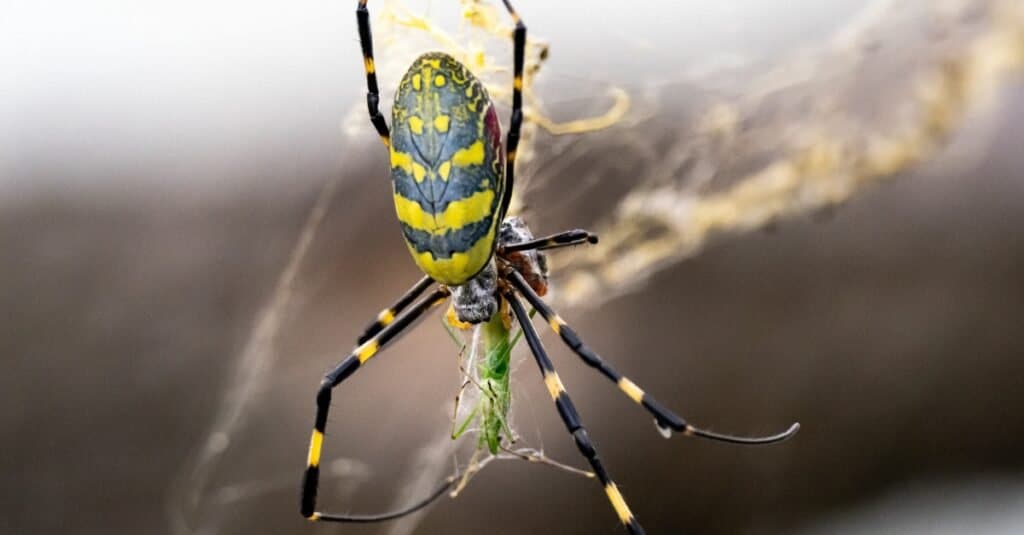
Female Joro spiders are more brightly patterned than males of the species.
©iStock.com/David Hansche
Behavior
While these spiders ordinarily keep to themselves, they have been making headlines since 2013 for their mass numbers collecting around homes and in the woods in 25 different counties in Georgia. Though the Joro spider is a relatively helpful creature to humans, the invasive nature of the species leads many people to become afraid of it.
While the Joro spider can appear rather large and intimidating and its orb-shaped webs tend to take over wherever they are attached, it is relatively harmless. Though it can release venom through a bite (which is different from being poisonous), it is not aggressive. The only time that the spider tends to bite is in an act of protection. For some people, this bite is painful, though the venom is not harmful or life-threatening unless you are allergic to this particular spider species. They’ll only bite as a way to protect themselves from threats — however, these spiders are unafraid to use this defense during mating as well, as the female will often eat the male that she mates with.
Still, these spiders have some sense of peace with other Joro spiders as they are able to live in groups in the same area without any other aggression.
To travel, it will use the wind current to “balloon” on, trailing its silk threads from its body to catch itself in the air and glide on the air currents to go up to 100 miles away. They’ll also use almost anything to travel, even holding onto a car bumper or cargo container.
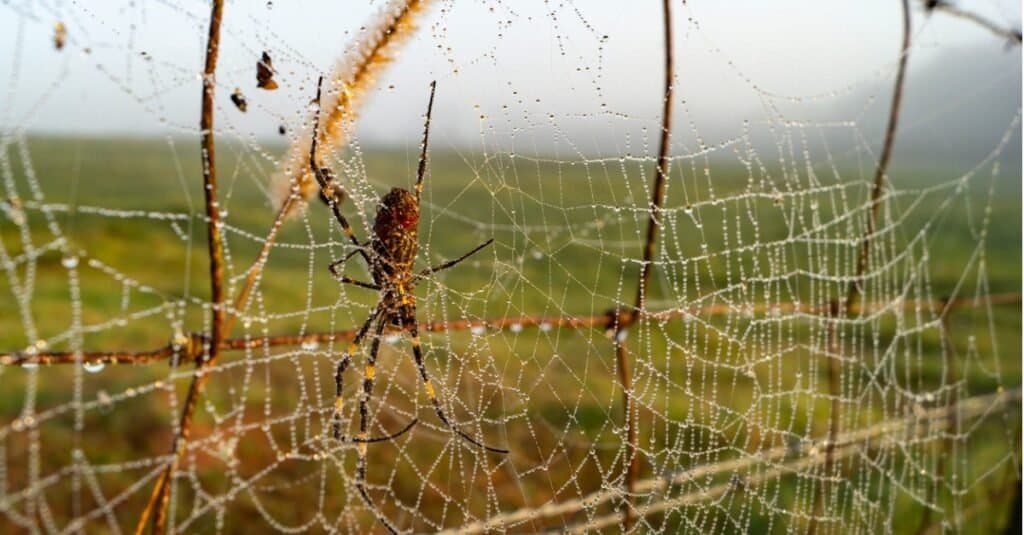
The Joro spider’s webs tend to take over whatever they are attached to.
©iStock.com/Lindsey Lee
Habitat
The main area of the world that the Joro spider lives in is within the borders of southeast Asia. They are found in Japan, China, Taiwan, and Korea, though they prefer areas with more humidity. They’ll build their home anywhere they can touch.
Since 2013, the spider has become an invasive species in the United States, primarily present in Georgia and the westernmost areas of South Carolina. They are likely to spread further to the East Coast. They don’t seem to have an adverse impact on the local ecosystems just yet, but the warm and humid environments are perfect for the arachnid to thrive. They consume some of the less beloved species of insects (such as the mosquito), and experts believe that they soon will be naturalized to the area.
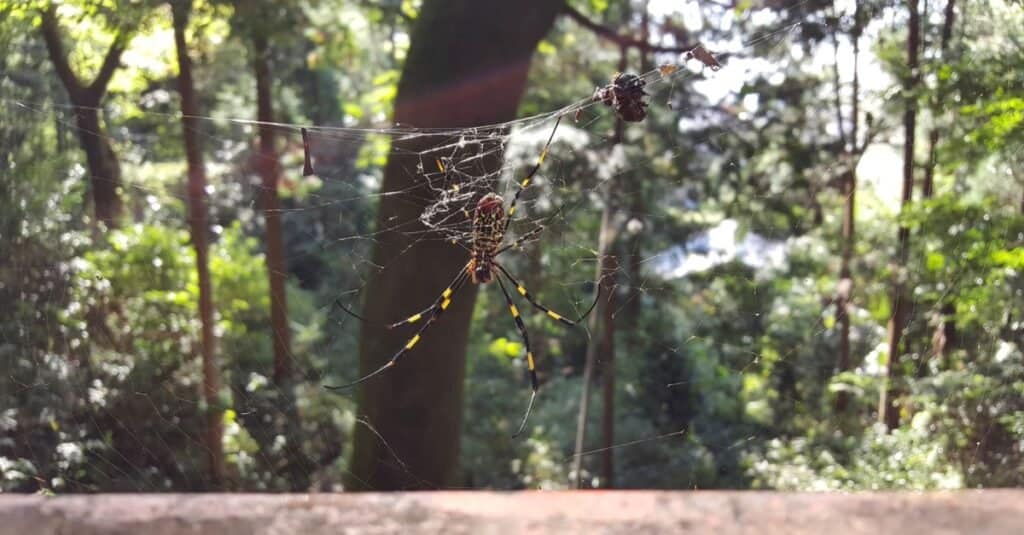
Since 2013, the Joro spider has become an invasive species in the U.S.
©Seve Sivathas/Shutterstock.com
Diet
The diet of a Joro spider is relatively helpful to the people around it. They are carnivorous, requiring the protein and other nutrients of insects to keep them healthy. Not much is known about the quantities they need to eat a day, but the fact that they go after common pests tends to make the public a little more welcoming to them.
Their diet is opportunistic of the warm and humid climate they need. Typically, mosquitos are the insect of choice, though they’ll also eat yellow jackets, stink bugs, and more. Their diet doesn’t impact the native species of spiders in the area, eating the insects that other spiders tend to avoid. The web is how they passively capture prey, though other spiders — like the dewdrop spider — have fallen victim to the appetite of this species of spider.
The only time that the Joro spider will go after a human or something outside of their standard diet is if they feel threatened.
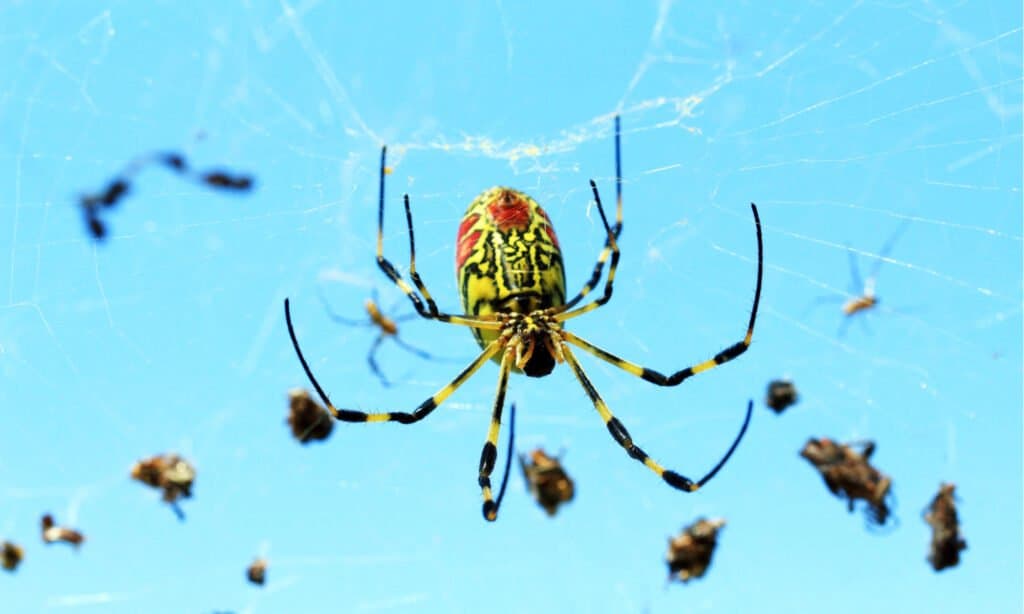
The Joro spider’s diet includes mosquitos, yellow jackets, and stink bugs.
©Surapong Kaewsa-ad/Shutterstock.com
Predators and Threats
Some birds go after Joro spiders, but there are no particular bird species that prefer them. While they may be eaten by other animals that eat insects and spiders, they don’t have a specific predator that seeks them out. Perhaps because they are an invasive species, there seems to be no natural threat to Joro spiders right now, so they have managed to spread rapidly.
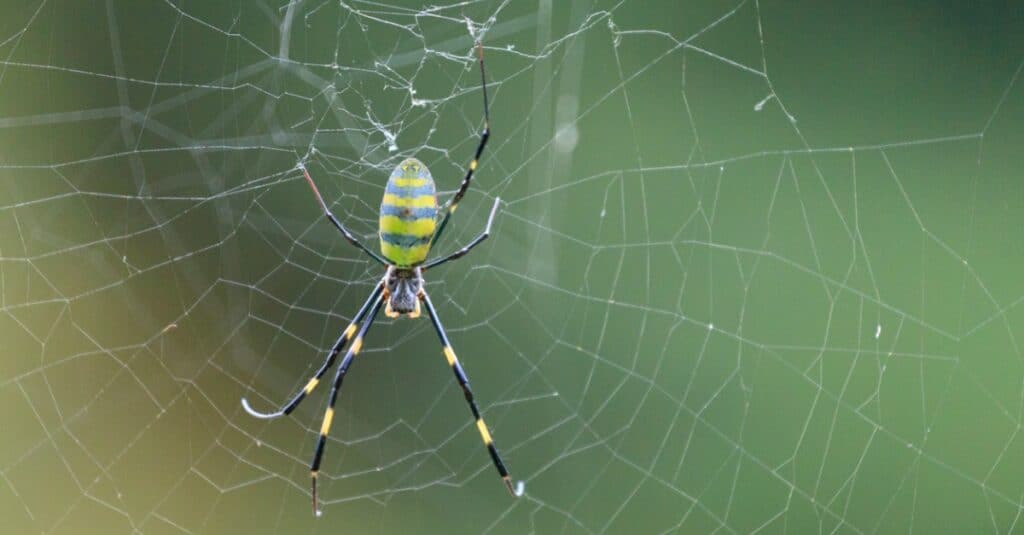
Joro spiders do not seem to have a specific predator that preys on them.
©iStock.com/Jef Wodniack
Reproduction, Babies, and Lifespan
Males reach maturity by the end of August when they are about two months old. Females take a little longer, reaching maturity no later than October at three to four months old. The male will join the female on her basket-shaped web, which hangs between tree branches, to mate. Though she may lay between 400-500 eggs, they are all contained within a single egg sac that is constructed from her silk.
When the baby is still within its egg sac with the others, the adults leave them behind and provide no care as they wait to hatch by summertime. Due to the short lifespan, females typically have no mate for life, coming together only for the continuation of the species. Though there are some cases of multiple males fathering the single egg sac or the female guarding the cocoon, these actions are not widespread enough to say whether it is typical of the species.
At birth, the babies can fend for themselves to eat, walking around just after they emerge. There is no specific name for this baby, though some baby spiders are called spiderlings. On average, both males and females live to be one year old. Adults typically cannot survive the winters as the temperatures drop far below their optimal warmth.
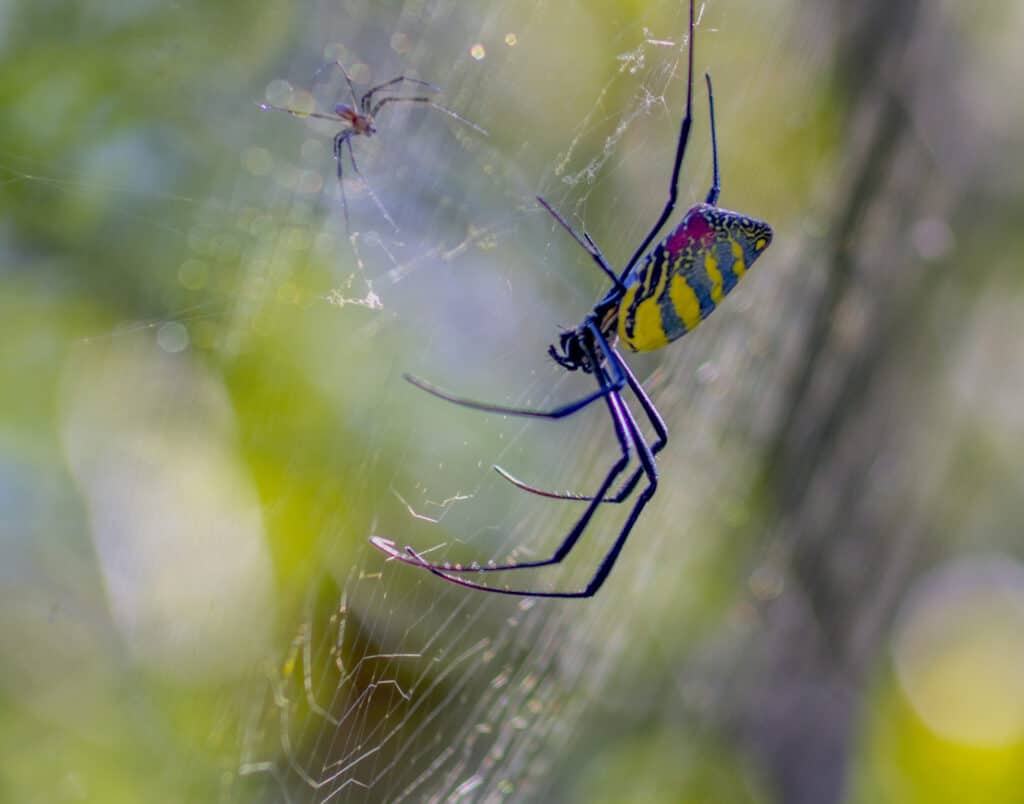
The smaller male Joro spider joins the larger female on her web to mate.
©iStock.com/LizMinkertJohnson
Population
At this time, it is practically impossible to say how many Joro spiders exist in the world. Their recent surge in population in the United States has left many people worried, which is why there are no current efforts to protect them. They are not endangered, and they seem to thrive in warmer regions. Their only threat is humans, but even those encounters have not been enough to bring down the population.
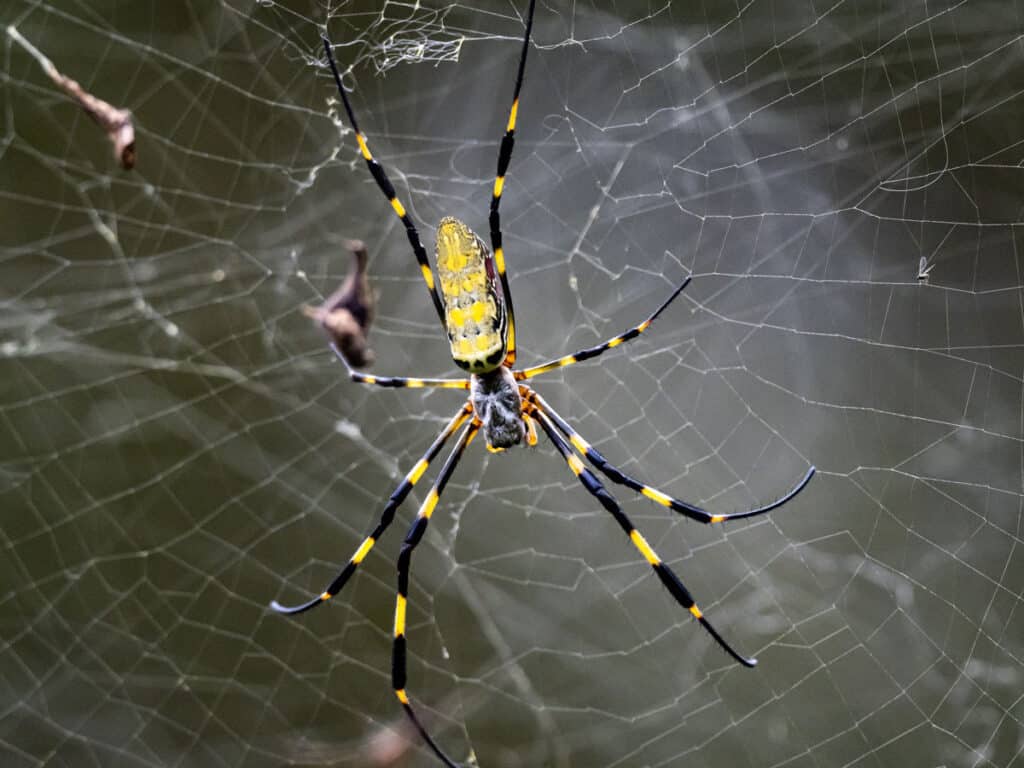
Joro spiders are not endangered and thrive in warmer regions.
©Dave Hansche/Shutterstock.com
Joro Spider FAQs (Frequently Asked Questions)
Why do Joro spiders balloon?
Ballooning in Joro spiders is primarily done by spiderlings. The main reason why is to find new places to live, but this can also help them avoid cannibalism and competition. Smaller adults may balloon if conditions where they live are poor, but this is rare.
Joro spider vs. praying mantis: Who wins?
If a Joro spider and praying mantis met one another it’s hard to say who would win. A praying mantis would likely have the advantage since they have a hard shell that may be difficult for Joro spiders to penetrate with their fangs. While the two may share an environment now, it’s unlikely they’ll compete since they’re both ambush predators.
Are Joro spiders bad and invasive?
Joro spiders are non-native to the United States and originally come from Japan. However, they’re not a “bad” species in that they curtail the population of mosquitos and aren’t harmful to any protected species.
Are Joro spiders carnivores, herbivores, or omnivores?
While the spiders are carnivores, the majority of other animals that they eat are insects. They are particularly helpful because the insects they go after are often pests that you want to leave you alone anyway!
Are Joro spiders poisonous?
Not exactly. They have venom, but their bite won’t actually hurt people because they aren’t poisonous. The only reason you should be concerned is if you are allergic to their venom.
How do I get rid of Joro spiders?
The easiest way to eliminate this type of spider is to kill them with direct contact, though some people prefer insecticide. Still, using insecticide can kill other insects in the area.
The best approach is a proactive one, keeping the home clean and all food put away to avoid attracting spiders in the first place.
Should I kill Joro spiders?
Not necessarily. Even though they are an invasive species, they benefit areas that have a lot of mosquitos and other bugs since they reduce their population.
Are Joro spiders good?
Yes! Keep these spiders around to get rid of yellow jackets, stink bugs, and mosquitos.
Where are Joro spiders found?
Typically, these spiders are found in southeast Asia. Interestingly, they didn’t show up in Georgia until about eight years ago.
Where do Joro spiders come from?
The most common regions with Joro spiders are Japan, Korea, China, and Taiwan.
Why are Joro spiders everywhere?
Joro spiders are an invasive species. They thrive in areas that are warm and humid, giving them plenty of food and comfortable habitats to thrive.
Where do Joro spiders lay eggs?
Anywhere! If the Joro spider can climb onto it, they can lay their eggs. Some people report finding their eggs on outdoor furniture, though they will also lay eggs in trees or through ballooning in the wind.
Do Joro spiders eat birds?
No. However, birds and certain species of wasps will dine on the Joro spiders.
How many eggs do Joro spiders lay?
In just one year, a female can lay up to 1,500 eggs.
Can Joro spiders tolerate the cold better than golden silk spiders?
Yes. Research was conducted, and Joro spiders were found to be able to tolerate the cold better than golden silk spiders.
Do Joro spiders jump?
No, Joro spiders do not jump. Instead, they use tiptoeing or rafting to balloon.
What are the similarities and differences between Joro spiders and writing spiders?
Joro spiders are both similar and different to writing spiders in some ways. Some differences are body size, web size, location, food choice, etc. Some of the similarities are how they get their food and their harmfulness to humans.
What are the differences between the banana spider and Joro spider?
The greatest differences between a Joro spider and a banana spider include their genus and species, along with their locations throughout the world. The Joro spider’s scientific name is Trichonephila clavata, and it lives in Japan, Taiwan, Korea, China, and parts of the United States. The banana spider is from the Nephila genus and lives in Asia, Africa, Oceania, and North America.
Thank you for reading! Have some feedback for us? Contact the AZ Animals editorial team.
Sources
- Monroe Country Reporter / Accessed November 13, 2021
- Better Homes & Graden / Accessed November 13, 2021
- CBS News / Accessed November 13, 2021
- The State / Accessed November 13, 2021
- The Guardian / Accessed November 13, 2021
- Athens Banner-Herald / Accessed November 13, 2021
- The Times / Accessed November 13, 2021
- gardening soul / Accessed November 13, 2021
- Newsweek / Accessed November 13, 2021
- Spider ID / Accessed November 13, 2021
- OxfordLanguages / Accessed November 13, 2021
- PMC / Accessed November 13, 2021
- npr / Accessed November 13, 2021
- UGATODAY / Accessed November 13, 2021
- Wikipedia (1970) https://en.wikipedia.org/wiki/Nephila Jump to top / Accessed November 13, 2021


















